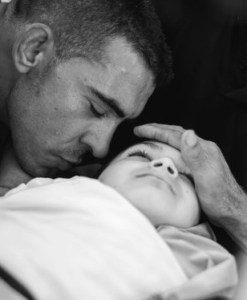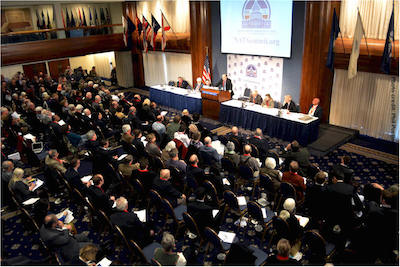Did Israel Have the “Right” to Kill This Child?
Sep 5 2014 / 5:35 pmBy James M. Wall.
Wallwritings – “Israel has the right to defend itself” was the Orwellian doublespeak Israel used to justify its latest invasion of  Gaza, carried out at the same time as its under-reported increased military action inside the West Bank.
Gaza, carried out at the same time as its under-reported increased military action inside the West Bank.
President Obama, eagerly joined by would be presidential candidates Hillary Clinton, Rand Paul, and Elizabeth Warren, rushed to endorse Israel’s 51-day August assault against the Palestinians, by proclaiming, “Israel has the right to defend itself”.
Prompted by AIPAC, the U.S. Senate voted unanimously to embrace the doublespeak Israeli claim that it was killing Palestinians “because it has the right to defend itself”. The vote was taken on the final day before the senators went into their annual summer recess.
Were there any among that list of endorsees who understood the meaning of “doublespeak”, which Wikipedia defines as “language that deliberately disguises, distorts, or reverses the meaning of words?”
Did that “right to defend”, give Israel the right to kill 11-year-old Khalil Muhammad al-Anati, just before he was to begin the sixth grade in the Al-Fawwar refugee camp school south of Hebron (see map below right)?
Khalil Anati died on Sunday morning, August 10. Israel’s invasion of Gaza was well under way.
When that invasion ended August 26, with a shaky month-long cease fire, according toUnited Nations figures, the invasion had killed 2,104 Palestinians in Gaza, “including 253 women (12 per cent) and 495 children (24 per cent).
During the same period, 69 Israelis were killed including four civilians (6 per cent).
The UN also reported “that 10,224 Palestinians, including 3,106 children (30 per cent) and 1,970 women (19 per cent) were injured in Gaza. Preliminary estimates indicate that up to 1,000 of the children injured will have a permanent disability and up to 1,500 orphaned children will need sustained support from the child protection and welfare sectors.”
Media attention during the invasion was focused on Gaza. Next door in the West Bank, the IDF stepped up its daily military incursions inside Palestinian population centers.
UNRWA, the United Nations Relief and Welfare Agency, describes the camp, where Khalil lived, died and is now buried.
The southernmost of the West Bank camps, Fawwar was established in 1949 on 0.27 square kilometres of land, 10km south of Hebron.
The camp’s original inhabitants came from 18 villages in the Gaza, Hebron and Beersheeva areas. Like other West Bank camps, it was established on land UNRWA leased from the government of Jordan.
The residents of the camp depend almost entirely on work inside Israel and have been especially badly affected by the inaccessibility of the Israeli labour market. Unemployment stands at 32 per cent.
Gideon Levy writes a regular column, “Twilight Zone”, for the Israeli daily Haaretz. His column has been described as “documenting unflinchingly, the myriad cruelties inflicted on the Palestinian people under occupation”.
After the killing of Khalil Anati, Levy (below left) traveled to the Al-Fawwar refugee town and camp. He wrote several stories on the death of Khalil Anati.
This is the start of one of the stories published August 21:
Khalil Anati was 10 years and eight months old and came from the Al-Fawar refugee camp, south of Hebron in the West Bank, when he was killed.
An Israeli soldier had opened the door of his armored jeep, picked up his rifle, aimed it at the upper body of the boy, who was running with his back to the soldier, and cut him down with one bullet, fired from a distance of a few dozen meters.
It was early morning on Sunday, August 10. The street was almost empty – the idleness, the unemployment and the heat in this squalid refugee camp leave people in their beds late – and the soldiers were apparently in no danger. According to testimony, there were only another three or four young children in the street; they were throwing stones at the jeep. There were no “riots” and no mass “disturbances.”
Khalil tried to advance another few meters after the bullet lodged in his lower back, before falling to the ground in the middle of the narrow alley, its width about that of a person, that ascends to his home. . . .
By the time he arrived at the hospital in Hebron – he had been transported in a private vehicle since the camp does not have an ambulance – he was dead from loss of blood.
The soldier who shot him, quickly shut the door of the jeep and hightailed it out of the camp, together with his buddies. Mission accomplished.
Khalil Muhammad al-Anati’s death and burial were also covered by Kelly Lynn, a photo journalist working in the West Bank.
Her report appeared in both Global Reserch, published by the Centre for Research on Globalization (CRG), an independent research and media organization based in Montreal, Canada, and in The Electronic intifada, an American web site started by and still led by, Ali Abunimah.
Kelly Lynn’s report in the EI begins:
Thousands gathered shortly before afternoon prayers on Sunday in Fawwar refugee camp south of the occupied West Bank city of Hebron to mourn the death of eleven-year-old Khalil Muhammad al-Anati.
Israeli soldiers shot Khalil with live ammunition outside his home that same morning on 10 August after forces invaded the camp. He was buried not far from his home that afternoon by thousands of friends, family and neighbors.
“Every time someone went to get him, the soldiers would start shooting. We couldn’t reach him. When we were finally able to get to him, he had lost almost all of his blood,” Yusif said.
After the jeeps vacated the area, Khalil was taken in a private car to al-Ahli hospital in Hebron, where he was treated by Dr. Mohammed Baker Abu Snaina.
“Upon arrival to our emergency room, he had no heartbeat, no pulse and no muscular or neurological reflexes,” said Abu Snaina. “There was no active bleeding because he had already lost most of his blood.”
Lynch tried to reach the Israeli army media desk to ask for an official description of the killing. She could not reach the desk.
However, a few hours after the killing, the Israeli military’s Twitter account stated in Hebrew its “regret” over the incident. It added the usual promise of an internal investigation.
Lynch’s report continued:
According to Amnesty International’s February 2014 report titled “Trigger Happy: Israel’s Use of Excessive Force in the West Bank,” Israeli authorities have consistently failed to carry out investigations into alleged crimes that satisfy international standards.
From September 2000 until June of last year, there were only sixteen military police investigations into the killings of Palestinian civilians by Israeli forces which led to indictments. None led to discharge from the military, according to Amnesty.
Meanwhile, back on the political campaign trail of one of the “Israel has the right to defend itself” American politicians, Senator Elizabeth Warren spoke to a group of Hyannis voters during one of her regularly scheduled “office hours” with her Massachusetts constituents.
Because so many progressive Democrats have turned to Warren as an alternative to front runner Hillary Clinton in the 2016 race for the presidency, Warren’s participation in the rush to endorse “Israel’s right to defend itself” was especially disappointing to her would-be progressive supporters.
Glenn Greenwald reported on Warren’s visit to Hyannis for Intercept:
At the Hyannis event, which was covered for the Cape Cod Times by reporter C. Ryan Barber, one voter objected to Warren’s recent vote, in the middle of the attack on Gaza, to send yet another $225 million of American taxpayer money to Israel for its “Iron Dome” system.
The voter, who identified himself as John Banger, told Warren:
“We are disagreeing with Israel using their guns against innocents. It’s true in Ferguson, Missouri, and it’s true in Israel . . . The vote was wrong, I believe.” To crowd applause, Bangert told Warren that the money “could have been spent on infrastructure or helping immigrants fleeing Central America.
Warren steadfastly defended her “pro-Israel” vote, invoking the politician’s platitude: “We’re going to have to agree to disagree on this one.” According to reporter C. Ryan Barber . . . Warren was also asked about her Israel position by other voters who were at the gathering, and she went on to explain:
“I think the vote was right, and I’ll tell you why I think the vote was right.
America has a very special relationship with Israel. Israel lives in a very dangerous part of the world, and a part of the world where there aren’t many liberal democracies and democracies that are controlled by the rule of law. And we very much need an ally in that part of the world.”
Warren continued in this vein, repeating the Israeli talking points about Hamas’ attacks on Israel “indiscriminately,” which were largely blocked by the Iron Dome defense system, which Senator Warren was eager to defend as American dollars well spent.
Pressed by another member of the crowd about civilian casualties from Israel’s attacks, Warren said she believes those casualties are the “last thing Israel wants.”
“But when Hamas puts its rocket launchers next to hospitals, next to schools, they’re using their civilian population to protect their military assets. And I believe Israel has a right, at that point, to defend itself,” Warren said, drawing applause.
Other than the standard Israeli line that civilian casualties are the “last thing Israel wants,” Senator Warren had nothing to say in Hyannis about Palestinian casualties.
If word has reached her, or her staff, about the killing of eleven-year-old Khalil Muhammad al-Anati, that news did not make it into her stump speech or into any answers she gave to her constituents.
The picture at top of a relative holding the body of Khalil Muhammad al-Anatim before he is lowered into the ground, was taken by Kelly Lynn, a freelance photojournalist based in the West Bank.
Her work focuses on refugee communities in the southern West Bank. She has been published on New Internationalist, Vice, Mondoweiss and others.

